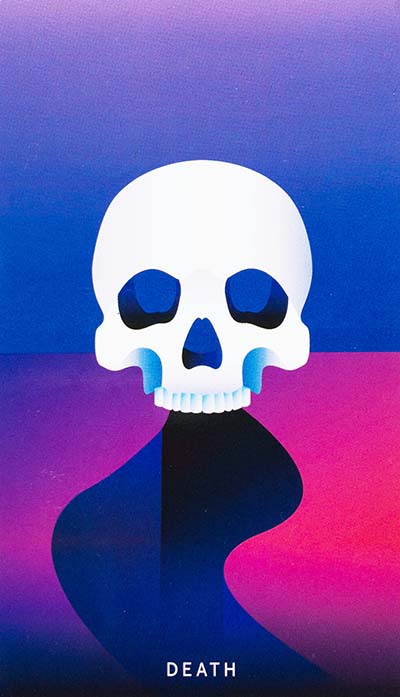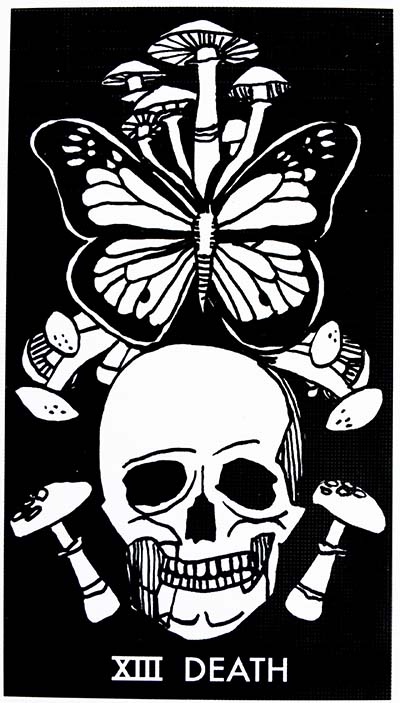Death Tarot Card Meaning
Keywords: Endings – Changes – Transformations
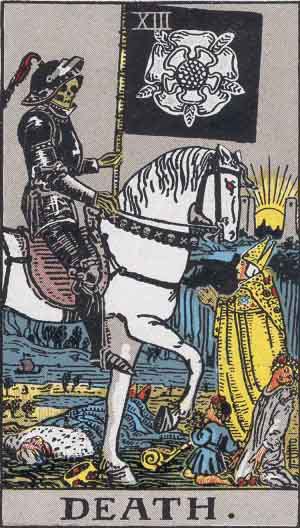
Description
An armored skeleton rides a white horse. He is the personification of death. He appears before a crowd barring a white flag with a rose. In the foreground, a king has fallen underfoot with his crown knocked over. A bishop prays for mercy. Another figure in the chaotic scene turns away from Death, having possibly fainted. A small child looks directly at the rider.
Beyond the gruesome, dramatic scene playing out in the foreground, there is a ship sailing peacefully in the river behind the chaos. Life moves on as usual. The sun rises beyond the outer bounds of the city. This scene will end and another one will begin. The sun beyond the city’s pillars suggests a transition into a new passage of life.
The Death card is the 13th card of the tarot’s Major Arcana. It is a card of endings, passages, transformation, initiation, and changes.
Upright Meanings for the Death Tarot Card
Death is probably the most recognizable card in the tarot. It’s been a horror movie staple to include the Death card (and or the Devil card) in an ominous reading foreshadowing doom. Its appearance is never a great sign for the film’s protagonist!
Luckily for the rest of us who receive it in a reading, it’s not a terrible omen of impending doom. The Death card rarely ever refers to literal death. Instead, it’s a symbol of the endings, both big and small, in our lives.
Death, like some of the other “scary” Major Arcana tarot cards (I’d include the Devil and possibly the Hanged Man in this list), is an inherently neutral energy. It’s not necessarily good or bad, it just is.
But, here’s the thing, we’re humans. We have complicated feelings. The Death card can indicate positive changes in your life that may feel bittersweet. For example, you may be happy to leave a job you hated for a much better opportunity, but you’ll deeply miss your coworkers. It’s important to honor the potential mix of relief and sadness you may feel about big changes. Sometimes the Death card brings unexpected and unwanted endings that cause pain. Honor that you may have difficult, complicated emotions that need to be tended to.
In another example, The Death card could appear in a reading about a new baby on the way. Rather than a cause for alarm, it’s a reminder that the new responsibilities you’re about to embark are going to shake up your life. You’d want to prepare for a few years of both interrupted sleep and a big reduction in leisure time. Whenever the Death card shows up, it ushers in powerful life passages and initiations.
The Death card can also represent a transformation of the self. If you’ve been experiencing difficulty, know that you’re going to come out of the other side stronger. This card can represent the discomfort that arises from powerful transformations. The new person you’re becoming could cause relationships to fall to the wayside. You’ll discover who really has your back. As difficult as it is, let the dead weight drop from your life as you evolve.
And know that powerful transformations can still feel uncomfortable while you’re in the midst of it. Allow the energy of the Death card to clear out what’s holding you back. The uncomfortable pruning away of toxic habits and people from your life will only lead to renewal and growth. The time after the Death card’s energy has passed will feel like a rebirth.
The Death card can be tied to changes that you didn’t willingly make. This happens to all of us during our lives. You may feel dragged alone into a situation that you didn’t want to experience. Accept that some things in your life are beyond anyone’s control. The king underfoot in the Death card reminds us that change comes for everyone. Talk to a trusted friend, counselor, or healer about difficult emotions.
Keep in mind that if you’re keeping a daily tarot journal, Death can appear in daily drawings too. It can be a little startling to see such a heavy card appear unexpectedly! Ask yourself what it means for your life at the moment. I’ve found that Death can be a reoccurring, stalker card if you resist the call of change too much. That means ignoring your impulses to do big things like going back to school, changing careers, releasing toxic relationships, or living your authentic self. There will be times where you’re called on to be the figure of Death itself to prune and cull the extraneous in your life.
Love and Relationships
Death in a relationship reading can indicate an ending or a period of passage. This doesn’t always mean there’s an impending breakup. Although it often indicates changes occurring after a period of difficulty. I’ve found with most of my clients it’s the beginning of a time of relief. For those not in a relationship, it can represent the beginning of a new one.
Still, the Death card may confront you to either end a relationship that’s run its course or accept that it’s transformed into something else entirely. It’s always in your power to choose your response.
Career and Work
The Death card in a career reading typically represents the natural end to a phase or a need for reinvention. As a practical example, it could indicate going back to school for training in another field. You may be feeling called to shake-up your direction. You may have even faced an unexpected or unwanted conclusion to your planned career trajectory. Use this opportunity to get in touch with what you truly want. Doors that close in one area of your life allow others to be opened.
In the workplace, the Death card could indicate joining a job that has recently experienced upheaval. Or, of course, it can be a warning that a shake-up is arriving soon.
The Death card as potential careers or job positions can sometimes be a little more literal and relate to fields around death and dying (plus taxes too). It can represent the funeral industry, death doulas, end of life care, and hospice. It can suggest careers that support others in powerful transformations and transitions such as counselors, therapists, coaches, or healers. Because of its astrological connection with Scorpio, it can represent jobs related to crime investigation.
People and Personalities
Individuals who are represented by the Death card are comfortable with change. They can be mysterious, intense, and at times a little matter of fact. These are people who have reinvented themselves throughout their lives like a phoenixes from ashes.
The Death card can also represent individuals born under the sun sign of Scorpio (born approximately October 23rd to November 22nd).
Death Reversed Tarot Card Meaning
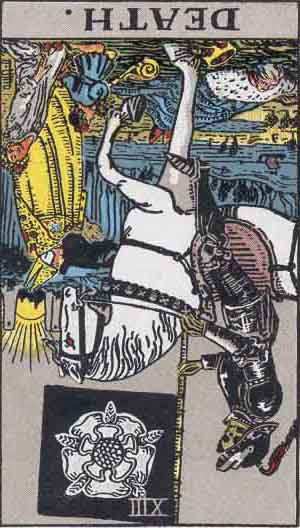
Reversed Keywords: Passage – Resistance – Stagnation
Reversed Meanings for the Death Tarot Card
On a positive note, the Death card reversed often represents that you’ve passed through a difficult time and have reached the other side. And as the saying goes, what doesn’t kill you makes you stronger. This is a message to honor what you’ve learned and the person you’ve become by experiencing these changes. It’s a great card that indicates you are ready to move forward.
Sometimes the Death card reversed suggests resistance to the changes you’re experiencing. You know whether you’re stuck and ignoring the writing on the wall. Don’t put your head in the sand. Find the balance between honoring going on your own time through this process while making sure you are moving forward. Resisting the natural force of change that this card brings can leave you stuck in a cycle of emotional pain and discomfort.
Similar to resistance, the Death card can represent a feeling of stagnation. The spark is missing that’s needed to spur action. This can show up during a lull in your life. You may want a change, but mustering up the motivation just isn’t happening. If this is the case, it can be helpful to pull additional cards in your reading to see what actions you should take to rekindle your fire.
Reversed Love and Relationships
Often Death reversed in a relationship reading
is a positive indicator that you are ready to move into a new relationship. This is particularly true if a difficult or unexpected separation has occurred recently. The worst of the storm has passed. You’re ready for something new.
For established relationships, it can signal the beginning of a new phase. This could be anything such as becoming new parents, getting married, or getting divorced. Expect big changes to the status quo.
Sometimes, this card reversed suggests that a past relationship might reappear. It can be a person returning into your life (or at least an attempt to return!). You may be surprised that some of your feelings for this person still linger. But, it’s a good idea to examine why the relationship ended in the first place. This might not be a fire that needs rekindling. It’s up to you to decide what to do next. Best your best self, wants, and needs in mind.
Reversed Career and Work
When the Death card shows up in a career or work-related reading, it’s often a warning not to ignore the obvious writing on the wall. Be cognizant of whether you or your workplace is ignoring important signs or trends. For a reversal, it could represent that an upheaval has already occurred. Now you’ll need to deal with the aftermath. The Death card brings the potential for such powerful, transformational energy to a reading. Examine whether it’s time for you to reinvent yourself.
It can show up if you’ve been procrastinating on leaving a job that you’re not satisfied with. You may dread for going into work. A feeling of being trapped usually accompanies this card when reversed. If staying in an unhealthy workplace is affecting your sanity, start making a transition plan. What steps do you need to take to leave this unfulfilling situation? The Death card challenges you to push yourself, even if it feels scary. Don’t allow fear to prevent you from growing.
Reversed People and Personalities
If this card represents you in the reading, it can suggest that fear has overtaken your ability to embrace change. As they say: feel the fear and do it anyway. Don’t try to control everything. Embrace the unknown.
Correspondences
Astrology: Scorpio
Element: Water
Numerology: 13
Affirmation
I honor endings and welcome new beginnings in my life.
History and Trivia for the Death Card
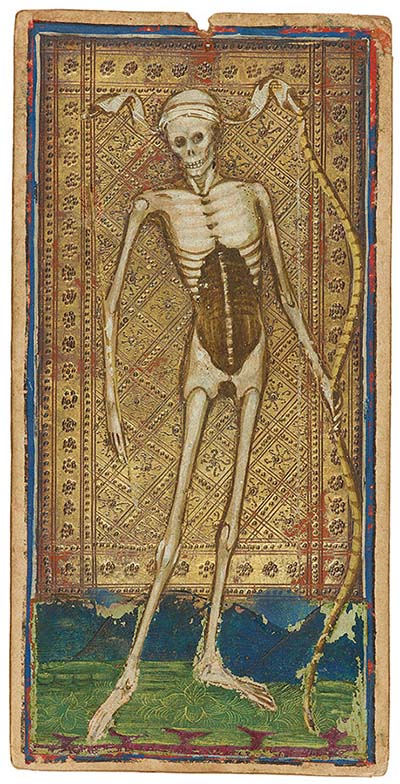
The Morgan Library’s Visconti-Sforza tarot. ca. 1450–1480
The Death card is visually one of my favorites in the tarot (along with anything else spooky and Halloween-y). It also has some interesting cultural history behind it.
Let’s start with the card’s number in the tarot: 13. In Western culture, the number 13 is generally considered unlucky. We even have a name for the fear of the number thirteen: triskaidekaphobia. Even you if don’t personally subscribe to the superstition, it still might affect your day-to-day life in subtle ways. For instance, you’ll find some hotels skip the 13th floor or number 13 room altogether. We also have plenty of superstitions around increased bad luck on Fridays that fall on the 13th of the month.
There are a lot of theories about the origins of an unlucky thirteen. One of the most commonly heard explanations in the West cites that it was the party of thirteen guests at the last supper before Jesus Christ’s crucifixion that brought the number it’s bad reputation. But many folklorists suggest that superstitions like Friday the 13th didn’t become popular until the 19th century (maybe a topic for a whole other blog post!).
Some of my favorite depictions of the Death card are from early tarot decks. Tarot is generally understood to have been created in the mid-1300s in Italy (see the Strange History of Tarot). This coincides with the first, and worst, recorded bubonic plague outbreak in Italy ¬–also known as the Black Death. From the island of Sicily, where the disease arrived by boat, it spread to Italy and then throughout the European continent.
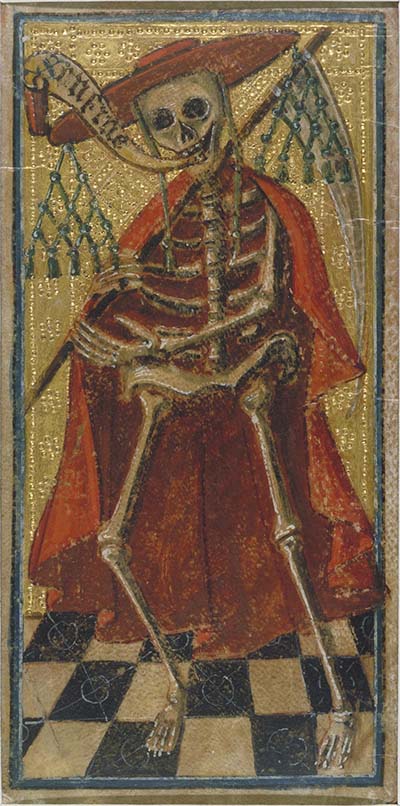
Tarot Card circa 1490s Italy. © Victoria and Albert Museum, London
The oldest preserved tarot deck we’ve found is the Visconti-Sforza from the late 1400s. Knowing that decks existed prior to the Visconti-Sforza (again, more information on that in the Strange History of Tarot), the cultural and psychological impact of the bubonic plague surely played a role in the macabre depictions of the Death in historical tarot decks. Throughout tarot’s early history, Europe will experience more plague outbreaks.
The Rider-Waite-Smith edition of the Death card features an only slightly gentler image of a skeleton on a white horse. This imagery is an allusion to a Bible verse that describes a scene from the apocalypse: “I looked and there before me was a pale horse! Its rider was named Death”. The flag with a rose in the RWS tarot suggests connections with legends of the Knights Templar and Rosicrucians (for more info on that, please see Arthur Waite’s book The Brotherhood of the Rosy Cross). I’ve always found it interesting that Waite chose to depict a ship sailing in the background of the image. It was via a cargo ship that the plague reached Italy during the Visconti-Sforza tarot’s era.
Some of My Favorite Examples
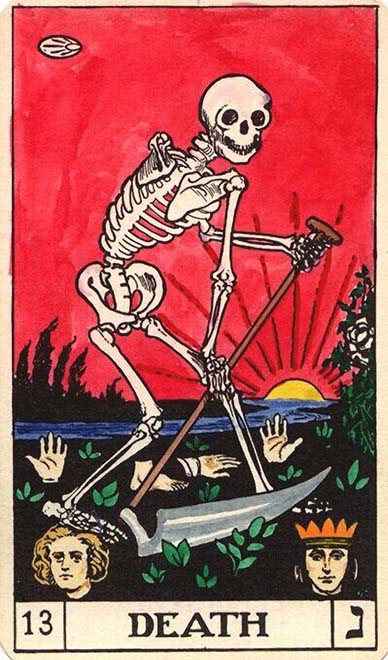
I think this might be my favorite Death card. A skeleton with an exaggerated grin sets off to do some harvesting. But he’s not harvesting just any old crop: it’s a fresh batch of disembodied heads. All of this is juxtaposed by a cheery sunrise behind him.
I think what I love about this card is the nonchalant ease of the skeleton as he does his business. Perhaps this isn’t such a sinister scene as it appears. Maybe he had a lot of errands to run today, so he woke up super early to deal with his lawn. Maybe those aren’t the heads of his victims, but just some very realistic mandrake root? Who knows what’s really going on here.
I’m not sure of the origin of this particular version of the Death card. You’ll find this image floating around places like Amazon.com on tarot merch (cell phones, bags, t-shirts, etc.). I think it’s a recoloring from a B.O.T.A. deck. The image itself, to the best of my knowledge, is inspired by a set of five 19th century tarot cards belonging to Stuart Kaplan of U.S. Games systems. This set was originally found by an antique dealer. The cards were causally stuck in a book for about a hundred years. Similar depiction can be found in Court De Gebelin’s drawings and some Etteilla decks. If anyone knows the full story behind this version, I would love to know!
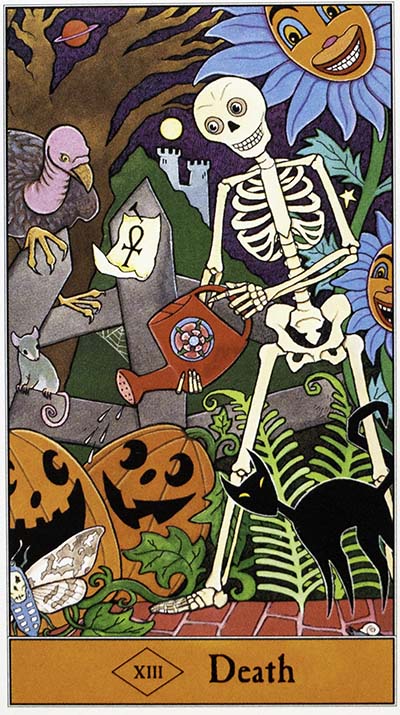
The Halloween Tarot (deck review coming soon)
The Halloween Tarot’s Death card draws on the holiday Día de Los Muertos, or Day of the Dead, celebrated in Mexico and the Americas. For the unfamiliar, Day of the Dead is celebrated on November 2nd, right after the Catholic holiday All Saints Day. Traditionally, this is a day of celebrating the return of ancestors and loved ones. Cemeteries are decorated and altars are set up with offerings to the dead. And of course, there’s a whole lot of skulls and skeleton decorations. Day of the Dead doesn’t beat around the bush in confronting morality. In fact, some of the traditional folk art of the holiday pokes fun at it. Día de Los Muertos is an apt metaphor for the spirit of the Death card. Everything is a cycle. Nothing truly dies –it’s only transformed into something else.
If you haven’t caught on already, I love a spooky Death card! The Mystic Mondays is pretty direct with its Death card. It’s an otherwise summery and colorful deck. Some of the minor arcana cards lean into non-representational imagery. But, that’s not the case for this Death card. It’s spooky, ominous, I love it! I have mixed feelings about tarot decks that gloss over the Death card by renaming it “Transformation”. I think its important to honor the discomfort and potential fear that change can bring.
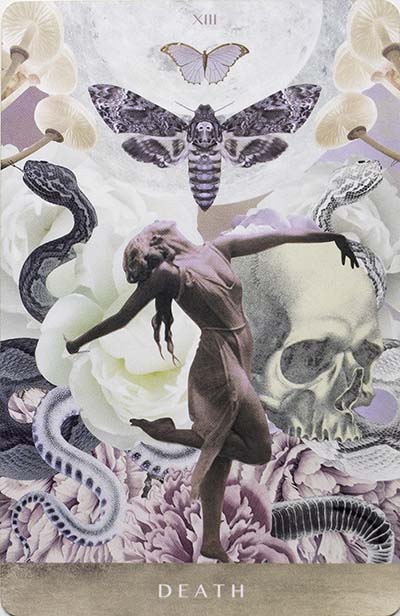
The Moonchild Tarot (deck review coming soon)
The Moonchild Tarot uses a beautiful collage of symbols to represent the energy of the Death card. The butterfly represents transformation. A snake transforms and renews itself by shedding its skin. There’s some traditional, spooky imagery thrown in for good measure such as the skulls and the deaths-head moth. The mushrooms are perhaps entheogenic and part of a sacred initiation. All of these images frame a dancer in an ecstatic pose. For many, the intense passages we experience through our lives can feel like an initiation of sorts. The energy of the Death card can encompass all of these contradictory impulses. It’s a complex card for a complicated state of being.
The Nomad Tarot by Jennifer Dranttel uses a similar motif of a skull, butterflies (transformation) and mushrooms (sacred initiation or a spiritual rebirth) for the Death card. This card was one of the first I saw of the Nomad tarot –making it a pretty much an instant-buy for me. The mushroom imagery is interesting to me as someone who’s dabbled in growing culinary mushrooms. Fungi are fascinating. Mushrooms break down materials and provide important nutrients to the soil. There’s even a type of fungus that consumes and breaks down oil spills. This makes it a potentially revolutionary tool for environmental remediation. Medicinal mushrooms such as shiitake, chaga, and lion mane can create healing compounds as they break down decaying matter. Keeping in the spirit of the Death card’s energy, mushrooms remind us of the cycle, and persistence, of life.
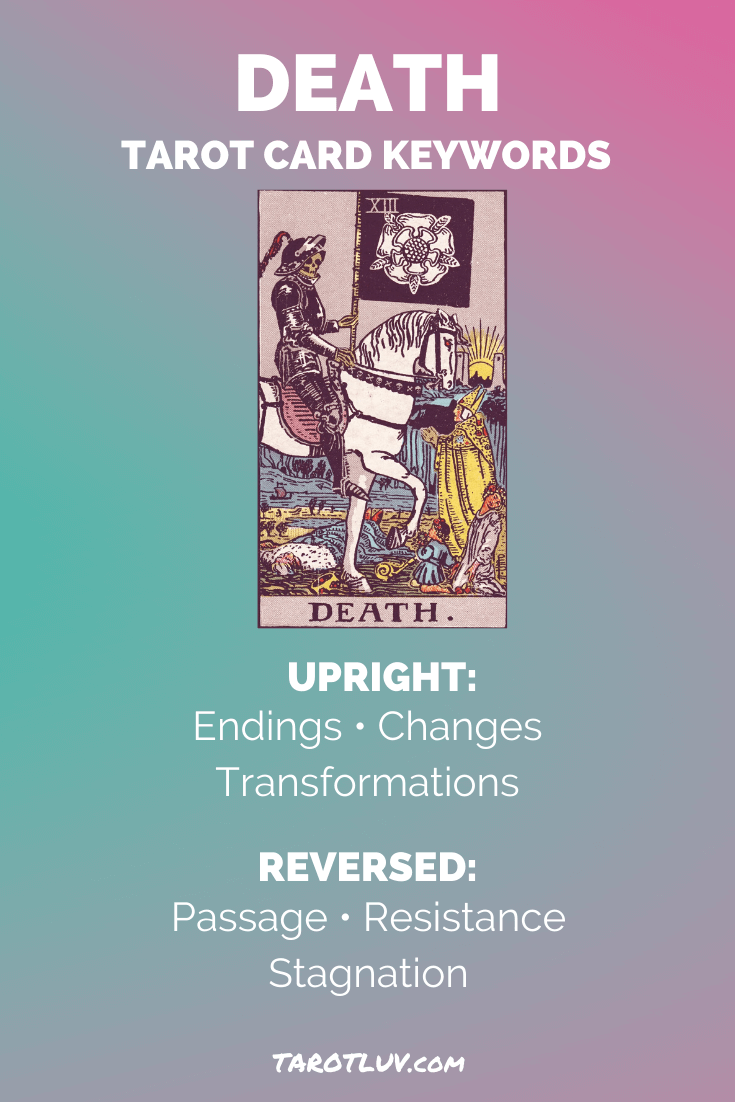
Death Tarot Card Keywords – Upright and Reversed
